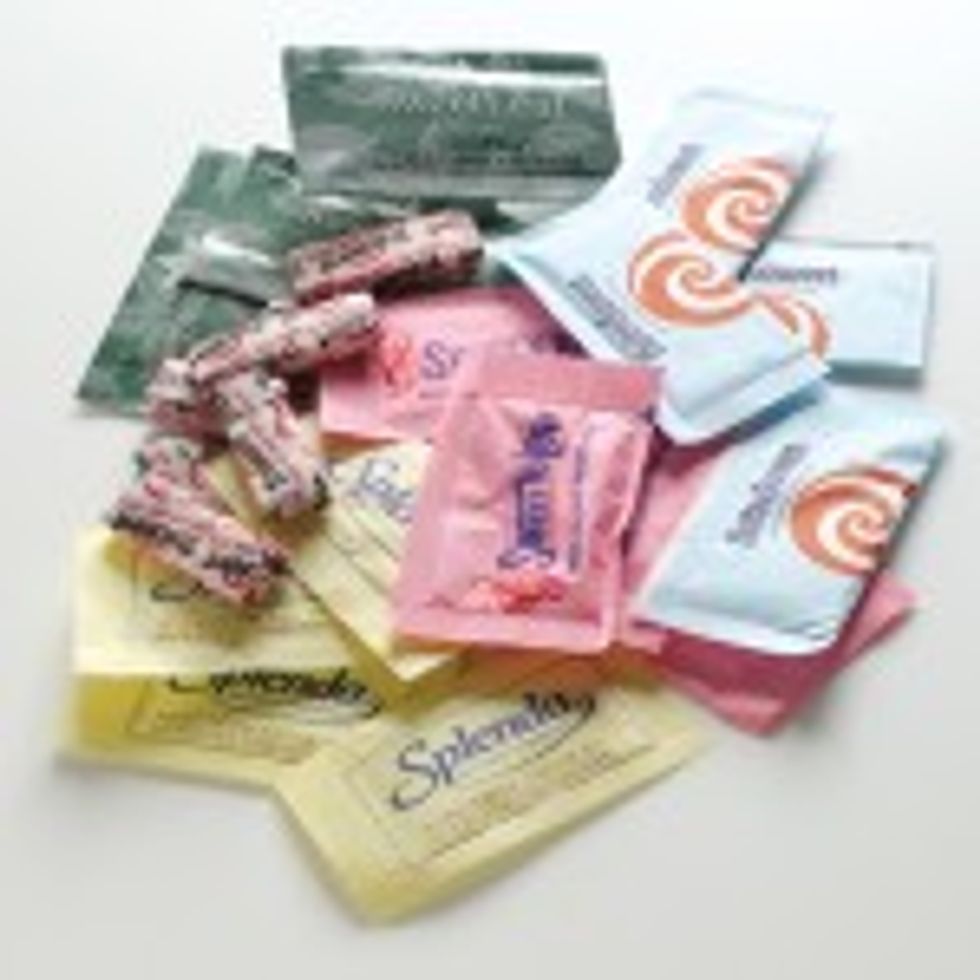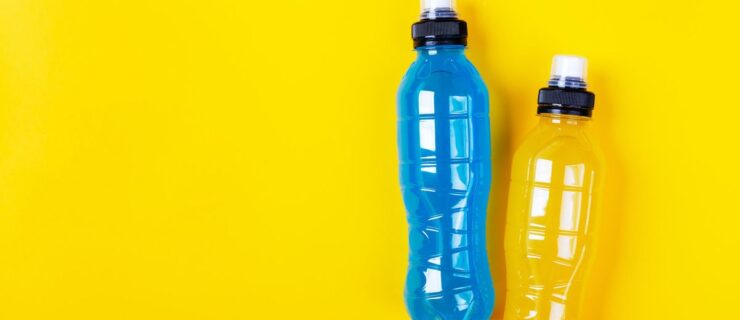All About Artificial Sweeteners

Get this: Each American consumes 31 teaspoons of sugar a day—that adds up to over 100 pounds of sugar a year! Our excessive sugar intake has been linked to obesity, Type 2 diabetes, heart disease, unruly behavior and cavities. In an attempt to trim down sugar intake, Americans have turned to sugar alternatives like artificial sweeteners and sugar alcohols. The increased presence of these sugar substitutes in our food supply has spurred concerns about their safety and nutritional value. Can sugar substitutes allow us to have our cake and eat it, too, or are they just another marketing gimmick created to lighten our wallets at the expense of our health?
Sugar in Disguise
Artificial sweeteners provide sweetness with limited-to-no calories, and dentists love them because they don’t contribute to tooth decay. The American Heart Association encourages people with diabetes to eat artificial sweeteners, and the American Diabetes Association considers sugar substitutes “free foods” since they have very few, if any, calories and keep blood-sugar levels from rising. The Food and Drug Administration (FDA) has approved the use of five artificial sweeteners—sucralose, acesulfame K, neotame, aspartame and saccharin—but approval doesn’t always translate to a clean bill of health. Here we’ll discuss the five sweeteners in order of safety—number one having the best track record and number five being the most questionable.
#1 Sucralose
What Is It?
Sucralose, better known by its trade name Splenda, is the only artificial sweetener made from real sugar. It tastes sweet and moves through the digestive tract without being changed or absorbed.
How Sweet Is It?
600 times sweeter than sugar
Claim to Fame:
Sucralose has a good shelf life and doesn’t degrade when exposed to heat. Additionally, numerous studies have shown that sucralose does not affect blood-glucose levels, making it a good option for diabetics.
Potential Problems:
To date, no adverse side effects have been linked to sucralose.
Where It’s Found:
Sucralose has been approved as a general-purpose sweetener for all foods and beverages. It’s marketed as a tabletop sweetener and for use in numerous products such as Diet Rite, Diet V8 Splash, Propel Water, Swiss Miss No Sugar Added.
Maximum Daily Intake:
Six milligrams or four cans of diet soda for a 120 lb person.
#2 Acesulfame K (Potassium)
What Is It?
Acesulfame K, better known as Sunett, is a highly stable, crystalline sweetener with a chemical structure similar to saccharin.
How Sweet Is It?
200 times sweeter than sugar
Claim to Fame:
Acesulfame K has an excellent shelf life and does not break down when cooked or baked. Most importantly for diabetics, acesulfame K does not raise blood-sugar levels.
Potential Problems:
It has a slightly bitter aftertaste.
Where It’s Found:
Diet Pepsi Max, Coca-Cola Zero, Fresca, Diet Coke with Splenda, Trident gum, Wrigley’s Spearmint gum, some SoBe products and sugarfree Jell-O. In carbonated drinks it’s almost always used in conjunction with aspartame or sucralose.
Maximum Daily Intake:
25 milligrams or 20 cans of soda for a 120 lb person
#3 Neotame
What Is It?
Neotame is made by the makers of aspartame, but is much sweeter and more stable.
How Sweet Is It?
8,000 times sweeter than sugar
Claim to Fame:
No adverse effects have been reported when individuals ingest neotame at the levels commonly found in foods. Since only a tiny bit of neotame is required to achieve maximal sweetness, it’s economical for manufacturers. It’s extremely stable, allowing for a long shelf life.
Potential Problems:
It’s too early to tell since the use of neotame is not as widespread as other artificial sweeteners.
Where It’s Found:
Neotame can be found in baked goods, soft drinks, gum, frosting, frozen desserts, jams, jellies, gelatins, puddings, processed fruit and fruit juices, beverages, toppings and syrups.
#4 Aspartame
What Is It?
Aspartame is composed of two amino acids, which are the building blocks of proteins. When combined, they have a pleasant, sweet taste.
How Sweet Is It?
200 times sweeter than sugar
Claim to Fame:
Aspartame is the most widely used and studied food additive. It’s best known as the main ingredient in Equal and NutraSweet. Unlike many other artificial sweeteners, aspartame does not have a bitter aftertaste.
Potential Problems:
Methanol and formaldehyde—which have poisonous properties—are generated during the breakdown of aspartame, but more than 100 toxicology and clinical studies have confirmed aspartame’s safety. Still, along with saccharin, aspartame remains a very controversial artificial sweetener.
Where It’s Found:
NutraSweet, Diet Coke and Diet Pepsi, Carefree Sugarless Chewing Gum, Dreyer’s (Edy’s) No Sugar Added Light Ice Cream
Maximum Daily Intake:
18 milligrams or 12 cans of diet soda for a 120 lb person
#5 Saccharin
What Is It?
Saccharin is the granddaddy of all sugar substitutes. It was accidentally discovered in the late 19th century by two scientists who didn’t wash their hands for lunch while working with coal tar. This led them to notice a sweet taste on their hands. Later this substance became known as saccharin.
How Sweet Is It?
450 times sweeter than sugar
Claim to Fame:
Saccharin is most well-known for its presence in Sweet ’N Low. Due to its long shelf life, saccharin is often used in diet fountain sodas, and its stability at high temperatures makes it an option for sweetening baked goods. Saccharin can also be made cheaply, making it economical for manufacturers.
Potential Problems:
In 1977, the FDA proposed a ban on saccharin due to concerns about rats that developed bladder cancer after receiving high doses of saccharin (in amounts comparable to 800 diet sodas a day). In 2000, after studies revealed no negative effects of saccharin use in humans, saccharin was removed from the National Toxicology Program’s blacklist of suspected cancer-causing substances. Currently, moderate saccharin use is considered acceptable.
Where It’s Found:
Saccharin is the primary ingredient in Sweet’N Low. It can be found in diet soft drinks like Tab and some sugar free gums like Trident.
Maximum Daily Intake:
12 milligrams or nine packets of artificial sugar sweetener for a 120 lb person
Sugar Smarts
Any substance can lead to health problems if consumed in large quantities. Furthermore, foods high in real sugar or sugar substitutes tend to contribute little or nothing when it comes to vitamins, minerals and other essential nutrients. Sugar substitutes also take the place of more nutritious foods, so they should be consumed in moderation. One or two foods containing artificial sweeteners or sugar alcohols daily should be fine, but you should choose foods that are as close to their natural state as possible.
Karlyn Grimes holds a dual master’s degree in nutrition and exercise physiology from Boston University, and is a faculty member in the nutrition and biology departments at Simmons College. Her nutrition and exercise book series for children is being published this spring. Visit scootercook.com.




